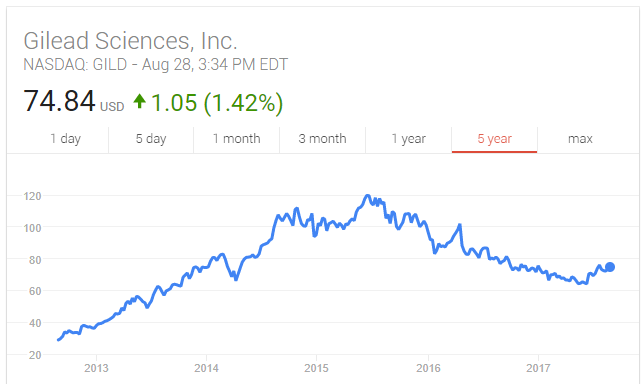It has been a tough couple of years for shareholders of Gilead Sciences (GILDGILD), the leader in treating HIV and Hepatitis C, or HCV. After shocking the biotechnology world by buying little known Pharmasset in 2011 for $11 billion, which gave them what would be become the leading HCV treatment, Gilead’s stock soared as Sovaldi (and later iterations of the drug) set a record for the best drug launch in the history of the industry.
However, as Gilead effectively cured thousands of patients in short order, it became clear that their HCV franchise would peak, and then slowly decline over time. As profits peaked and turned down, so did GILD shares, beginning in 2015:

What happened next was a classic Wall Street (read: short term focused) reaction. The stock went from darling to dud because Gilead had nothing in their drug pipeline that could offset the loss of HCV revenue after those initial patients were cured. At the beginning of 2017, GILD stock fetched $72, or just 6 times trailing 12-month free cash flow. A free cash flow multiple of 15-20 is pretty normal for the pharma and biotech space, so investors were essentially saying that GILD was going to see its profits decline more than 50% permanently.
I started buying the stock in late 2016 because the situation seemed very similar to instances when quality drug companies come to the end of the patent life for one of their best selling medicines. Knowing that generic versions are coming, investors drastically cut the earnings multiple they are willing to pay, in case new drugs never come to pass.
Of course, this ignores the fact that the vast majority of the time those same companies take actions to limit the profit decline and eventually grow again. In my October 2016 quarterly letter to clients I wrote the following:
“The negative case for Gilead ignores the fact that corporations are very much like living creatures; they do not exist in a vacuum but rather can pull other levers and take actions to offset negative events. For instance, what happens if Gilead discovers new medications for other diseases? What if they siphon profits from their HCV drugs to acquire other companies in order to diversify their product pipeline? What if they use profits to repurchase their own stock, making each remaining share more valuable? Better yet, what if they do all three?
For example, Pfizer’s cholesterol drug Lipitor had sales of $9.6 billion in 2011. In 2012 sales fell by 60% after the patent expired and generic versions hit the market. To reflect this known reality, Pfizer stock closed out 2011 trading for $21 per share, or roughly 9x annual earnings. By 2015, Lipitor sales had plunged by nearly 90% but Pfizer’s annual earnings had only fallen by 5% as other products filled the void. Pfizer stock ended 2015 trading at $32, or 14x annual earnings.”









Leave A Comment